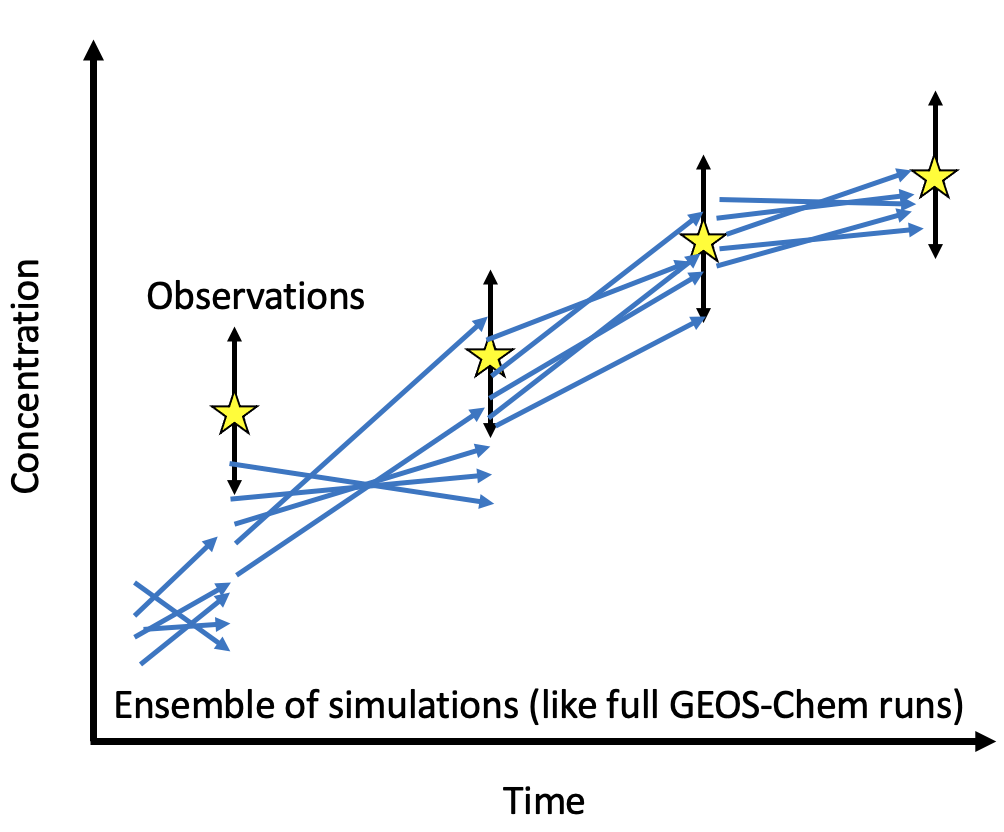About
The GEOS-Chem CHEmistry and Emissions REanalysis Interface with Observations (CHEEREIO) is a free, open-source tool which supports data assimilation and emissions inversions for arbitrary runs of the GEOS-Chem chemical transport model via an ensemble approach (i.e. without the model adjoint). For example, CHEEREIO can be used to estimate emissions of various pollutants using observations from platforms including satellite-based spectrometers. For more information, including a plain-language summary, see the About page.
Why use CHEEREIO
CHEEREIO is a tool for chemical data assimilation characterized by its flexibility. It can assimilate any kind of observation (satellite, surface, or aircraft) for any species in any configuration of GEOS-Chem, applying updates to both emissions scaling factors and chemical concentrations. CHEEREIO allows for wide flexibility in what can be assimilated, and for example allows for the user to (1) update observations at multiple time points in the assimilation window (e.g. hourly data updates for a daily window), and (2) assimilate observations of derived quantities such as PM2.5 or AOD. Many different kinds of observations can be used at once to update a family of species. For example, one might want to use NO2 satellite and surface data, SO2 satellite and surface data, NH3 satellite data, AOD, and surface PM2.5 to update emissions and concentrations of NOx, SO2, and NH3 . Whether applying this sort of update in a small nested region or for a global simulation, CHEEREIO can be configured from a single JSON settings file to support just about any kind of chemical data assimilation problem: whether it’s multi-species, multi-platform, linear or non-linear.
Users can easily extend to CHEEREIO to support new observational platforms without modifying CHEEREIO or GEOS-Chem source code. Instead, all users need to do is write a new class inheriting from the “Observation_Operators” template supplied with CHEEREIO. CHEEREIO allows users to go from idea to a working data assimilation demo in days, rather than months (or years).

The LETKF algorithm
CHEEREIO’s flexibility is enabled by the algorithm it runs under the hood: the localized ensemble transform Kalman filter (LETKF; Hunt et al., 2007). As the name suggestions, the LETKF algorithm follows an ensemble approach. This means that CHEEREIO is managing many (often 32 or 48) simultaneously running simulations of the atmosphere, each representing different assumptions (usually represented in the form of varying emissions scaling factors). The ensemble itself thus represents our uncertainty of the atmospheric state that arises from the uncertainty in our assumptions (e.g., the range of ammonia concentrations we would expect to arise in the atmosphere given our uncertainty in ammonia emissions). We might have some observations of the real atmosphere at a given time, such as those from a satellite column, from surface measurements, or from an aircraft campaign. This observation, which comes with its own uncertainty, constrains the reasonable range of concentrations our model should represent. Even if we only observe a related species, we still may have some useful information that will allow CHEEREIO to update the emissions and concentrations of interest. As the figure below demonstrates, this results in updates of the entire ensemble to better match reality.

Code
CHEEREIO code is freely available from our Github repository. An installation guide is provided in the online documentation.
Support and documentation
A high-level overview and demo of the software is given in our model description paper in Geoscientific Model Development. An extensive manual for CHEEREIO is provided in our online documentation. For support, please open a Github issue so that all users can see the solution. You can also email the lead developer, Drew Pendergrass, at pendergrass [at] g [dot] harvard [dot] edu.
Citing CHEEREIO
We ask CHEEREIO users to cite the CHEEREIO 1.0 model description paper in their publications:
Pendergrass, D. C., Jacob, D. J., Nesser, H., Varon, D. J., Sulprizio, M., Miyazaki, K., & Bowman, K. W. (2023). CHEEREIO 1.0: A versatile and user-friendly ensemble-based chemical data assimilation and emissions inversion platform for the GEOS-Chem chemical transport model. Geoscientific Model Development, 16(16), 4793–4810.
Funding statement
CHEEREIO has been supported by the National Aeronautics and Space Administration (NASA; Carbon Monitoring System; grant no. 80NSSC21K1057). Drew Pendergrass’s work on the project was funded by an NSF Graduate Research Fellowship Program (GRFP) grant.